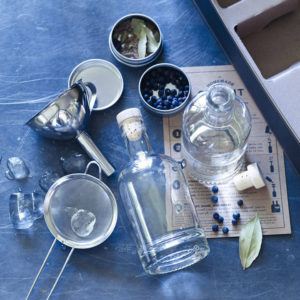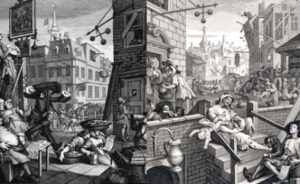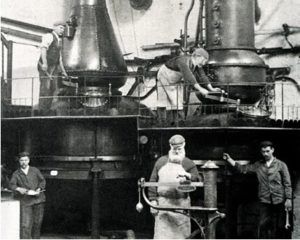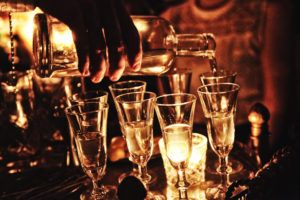You may be an eager gin and tonic drinker, but do you know your gin facts?
From the origin of the spirit to its most famous imbibers, there’s much to know about this beguiling beverage.
Straight from the Sipsmith Head Distiller, published author, and all-around drinks authority Jared Brown, these 50 gin facts might well change everything you thought you knew about gin….
gin
1. Gin is English – not Dutch. Genever, a malted spirit that is essentially light whisky with juniper, is the juniper distillate of the Netherlands. Gin was developed in London and is a unique and much purer spirit.
2. In Holland, genever was sold in pharmacies in the late 1600s. If you went to a drinking establishment, one of the top-selling beverages was wormwood wine – vermouth.
3. File under delicious gin facts: Gin was born around 1689. The earliest known food pairing occurred in 1731: gingerbread. This became quite common and is still traditional in parts of England.
4. The Martini glass only got its name in the 1990s, when Martini-style cocktails became all the rage. Prior to that, it was called a cocktail glass. Just as long as no one calls it an Appletini glass. . .
5. The earliest mention of the word ‘cocktail’ in reference to a drink was on 20th March, 1798 in the London Morning Post and Gazetteer (how’s that for historical?) In the newspaper’s satirical account, it was consumed by Pitt the Younger at the Axe and Gate Tavern at the corner of Downing and Whitehall, which was later torn down to expand the Prime Minister’s residence.
6. London’s most popular drink in the winter of 1823 was the Hot Gin Twist. One man wrote a 149-line poem for the newspapers extolling its virtues. Another wrote a shorter poem extolling both the drink and the previous poem.
7. The first cocktail listed in the first British book to contain cocktail recipes, William Terrington’s Cooling Cups and Dainty Drinks, was a gin cocktail with ginger syrup, orange curaçao and bitters.
8. By 1726, London had 1,500 working stills and there were 6,287 places where you could buy gin.
9. Centuries before the birth of gin, juniper was already imported to Britain from the Mediterranean. It is considered the best in the world.

Still Gin-terested?….
10. Getting technical with our gin facts: A martini is made with gin and sweet vermouth; a dry martini is made with gin and dry vermouth; a dry vodka martini is made with vodka and dry vermouth.
11. Gin and tomato juice was all the rage as a hangover cure in New York City in 1928, years before the vodka-based Bloody Mary made its debut at the King Cole Room in the St. Regis Hotel.
12. Nearly all juniper used in gin is picked wild. Almost none is cultivated.
13. While British sailors received a daily rum ration, British naval officers got a daily ration of gin. Lucky devils.
14. The gin rickey was the most popular gin drink of the late 19th and early 20th centuries. It is a simple drink: a highball glass of gin, ice, sparkling water and half a lime squeezed and dropped in. There is no sugar in a rickey.
15. Even though the cinchona bark from which quinine is derived is brown, the first tonic water was clear. This is because even the earliest tonic waters were made with quinine directly, not the bark.
16. The olive was popularised in cocktails when American drinkers began moving from sweet to savoury flavours in the late 1800s.
17. If Winston Churchill ever bowed toward France with gin in hand it was not because he did not like vermouth in his Martini. It would have been out of respect, because the Vichy government had banned alcohol production and good French vermouth was unattainable.
18. British naval ships were supplied and mixed their daily drinks with limes rather than lemons (which contain more vitamin C) as British investors with connections in Parliament had invested in Caribbean lime plantations.
19. Hogarth’s famous etching, Gin Lane, was not meant to show the evils of drinking, but the evils of drinking gin. It was one of a pair. The other was Beer Street and showed London as he envisioned it consuming beer instead of gin. Here the citizens were a perfect picture of health, as morbid obesity was considered healthy at the time.

On with the Ginventory….
20. Little-known gin facts: the best way to taste gins for comparison is at room temperature, diluted with an equal measure of water. This reveals both qualities and flaws.
21. The country with the world’s highest per-capita gin consumption is the Philippines, with an estimated 25 million cases consumed annually.
22. Gin’s primary flavour is the sweet pine and soft citrus of the juniper berry. All other botanicals are added to highlight nuances of this complex and sophisticated flavour.
23. The juniper berry is actually not a berry at all. It is a female seed cone, a highly evolved pinecone with fleshy and merged scales that give it the appearance of a berry.
24. During the plague years, doctors wore masks filled with juniper berries as they thought the plague was spread by bad odours. People began eating juniper, drinking wine infused with juniper, bathing in juniper and covering themselves with juniper oil. This is considered superstition by modern historians, but juniper oil is an effective natural flea repellent.
25. The Gin Act of 1736 imposed an annual fee of £50 (equal to about £20,000) on distillers of base spirits and the same again on gin rectifiers. Thus, it became traditional for London gin distillers to buy their base spirit rather than producing it in the distillery.
26. In 1721, Britain consumed 3.5 million gallons of gin.
27. At Yalta, President Roosevelt complained that there were no lemons to make twists for the martinis. Stalin had a lemon tree flown from Georgia that day.
28. After Sir Francis Chichester became the first man to successfully circumnavigate the world solo in a sailboat (say that three times after three Martinis!), he credited his success to a daily glass of pink gin (gin, Angostura bitters and cold water), and said the saddest day was when the gin ran out.
29. At one time there was a working gin still in one out of every four habitable structures in London.
30. Faced with government acts that seemed poised to stamp out gin production, Londoners stages a mock funeral for Madame Geneva in 1736.

31. Until recently, Plymouth Gin was the sole gin style in the UK to boast geographical indication. However, that will soon disappear, as owner Pernod Ricard has withdrawn their support for the EU endorsement.
32. London Dry Gin doesn’t need to be made in London – instead, it is a broad style guideline rather than a legal indicator.
33. The gin and tonic has lately undergone a transformation in Spain, where the “gin tonic” is served in balloon wine glasses and comes with all kinds of unusual botanicals.
34. The “bathtub gin” that was made in the United States during Prohibition had dangerous – even lethal – physical effects due to the fact that it sometimes contained methanol. Sufferers were blinded or even poisoned.
35. However, we do have bathtub gin to thank for many classic cocktails (the Bee’s Knees being a prime example), as the initial recipes were devised to help mask the task of the low-quality alcohol.
36. While bartender Harry Craddock, who wrote the seminal Savoy Cocktail Book, is often credited as one of the early popularisers of the Martini, the source of the drink’s name is still a mystery.
37. Old Tom Gin originated in the 18th century, and is generally a rounder and sweeter style than London Dry Gin.
38. The birth of cocktail culture in London can be credited in part to the rise of the so-called “American bars” in the early 20th century, which were known for their innovations – like the fact that they used ice in their drinks.
39. Barrel-aged gin is an expanding, relatively new gin category, with craft distilleries like Few Spirits in Illinois and St. George Spirits in Northern California helping to spread its popularity.
40. No gin and tonic of quality can be made without high-quality tonic as well, as the tonic makes up a significant proportion of the drink. Artisanal tonic makers like Fever-Tree are recommended, while tonic producers like C&B in San Francisco are refining the art of tonic water by making their own, small-batch tonic syrup.

41. Dukes Bar in Mayfair’s Dukes Hotel is often cited as home of the best Martini in the world. Drinks are mixed on a tableside trolley, and the bar maintains a strict two-Martini limit.
42. Sloe gin is made with the handpicked berries of the blackthorn tree. While some superstitions say the berries must be pricked with a silver needle before use, this isn’t necessary – simply freezing the berries in order to break their thick skins before adding to the gin should suffice.
43. Sloe gin pairs exceptionally well with strong, blue cheeses – though it’s also equally palatable in more summery drinks.
44. Gin must legally have a “predominant juniper flavour,” but there are no specifications or limits to how many other botanicals may be used, or the quantity of juniper berries that need to be added during the distilling process.
45. While some distilleries produce gin concentrates, which they later ‘water’ down with a neutral spirit, traditional one-shot distillation distils the botanicals with the spirit.
46. The pipe at the top of a gin still is also known colloquially as the ‘swan’s neck’ – hence the swan illustration that you’ll find on Sipsmith’s labels.
47. The Martini has prompted a great deal of poetry. Writer E. B. White called it “the elixir of quietude,” while journalist H. L. Mencken said it was “the only American invention as perfect as the sonnet.” However, given the murky origins of the Martini, whether or not it’s truly American is still disputed.
48. Though James Bond’s famous “shaken, not stirred” line is probably the most remembered Martini quote in the world, the majority of bartenders disagree, and would recommend a stirred Martini instead, as shaking prompts too much dilution.
49. Ian Fleming, the author of the James Bond books, left an additional impression on gin drinkers: he’s credited with inventing the Vesper, a cousin of the Martini that blends gin, vodka, and vermouth – topped with a lemon twist.
50. The gin and tonic first gained popularity in the British colonies, as the quinine in the tonic water was found to be a potent deterrent to malaria-carrying mosquitoes. However, the bitterness of the quinine was unpalatable, so gin was added to make the drink taste better.

 Privacy Policy - your information will never be shared
Privacy Policy - your information will never be shared